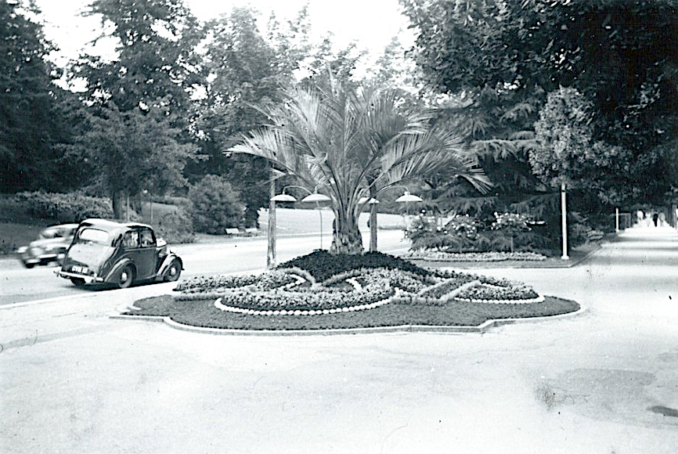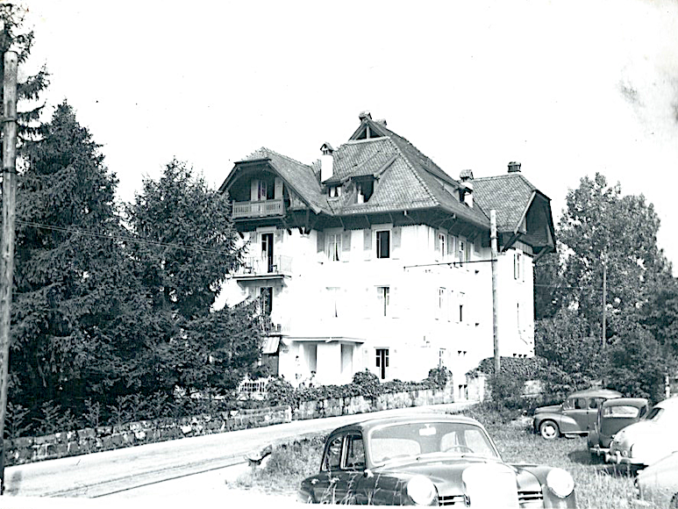
© Google Maps 2023, Google
As we continue our clockwise drive around Lake Geneva our first and brief port of call is Lausanne, the capital and largest city in the French-speaking Swiss canton of Vaud. Lying at an elevation between 1,726 ft and 3,068ft, in 1950 the population was about 106,000 whereas by the year 2000 it had risen to 125,000. Famous residents tend to be outsiders, there for tax purposes, to avoid wars or as a result of forced exile.
However, an interesting section on Continental Wikipedia is headed ‘notables indésirables.’ Besides the usual, harmless and entertaining small-town Nazis one encounters everywhere in MittleEurop, sits a M. Serge Voronoff, inventor of a medical therapeutic ‘remedy’ which involved stitching monkey testicles onto one’s own.
A prolific author of works such as ‘Testicular Grafting from Ape to Man’, ‘How to Restore Youth and Live Longer’ and ‘From Cretin to Genius’, Russian-born M. Voronoff was mocked during his lifetime – while living in luxury from the proceeds of his quack medicines in Lausanne and Nice.
Elsewhere on the wall of infamy sits Marie Manning. Born Marie de Roux in 1821, the Lausannoise and her husband were convicted of the Bermondsey Horror murder of a Mr Patrick O’Connor at Miniver Place, Bermondsey, in order to steal his railway shares.
As well as the home to quack remedies, murderous maids and iron-cross-clad uber-deplorables, Lausanne hosts the International Olympic Committee, in much the same way last week’s desination Nyon was the headquarters of the Union of European Football Associations. The IOC’s facilities lie on the waterside at Quai d’Ousy and, as with UEFA, the administrators live rather well. The Olympic Museum, Villa Olympique and Pac Olympic look onto Quie d’Oucy where we shall assume photograph one was taken.

© Always Worth Saying 2023, Going Postal
Off camera, the lake lies to the right, ornamental gardens are in the centre with the road and gently rising lakeside land sitting to the left, as does my grandparent’s intrepid Ford Prefect.
Having a look around via Street View link the shows a ferry stop with the lake steamer Helvetie alongside – more of which after we leave Montreaux. The Quai only stretches for about 600 yards from the curved Quai de Belgique to the Tour Haldimond after which private dwellings hog the waterfront. Travelling around the shore for a further eleven miles, we reach the town of Vevey, home of the giant Nestles corporation. Now only minutes from Montreaux we take a detour up the hillside to Blonay which is the caption for photo number two.
En route, we pass Chaplian’s World, a museum dedicated to the Holywood star of the same name. Located in the Manoir de Ban, his impressive former home and gardens, the attraction includes wax works of Chaplain and his characters as well as politicians and artists who crossed his path. Given London-born comedian was a Communist, conscription dodger, tax avoider and husband to two sixteen-year-old girls no doubt there is a notables indésirables plaque attached to a statue of a giant bar of chocolate somewhere nearby.
Besides school girls Mildred Harris and Lillita MacMurray, and ultra-mature 26-year-old Marion Levy, Chaplain married 18-year-old Oona O’Neil, daughter of Nobel laureate Eugine O’Neil who disapproved of the 36-year age difference. In the end love triumphed with Oona and Charlie having eight children and remaining married until Charlie’s death in 1977 at this Corsier-sur-vevey manor. Dividing the rest of her life between the United States and Switzerland, Ooona passed at Vevey 14 years after her husband, aged 66.

© Always Worth Saying 2023, Going Postal
Our photo is captioned, ‘Hotel Bloney’. In the distinctive Swiss chalet style, it would be easy to locate on a Skelmersdale council estate but difficult to find in a sprawling Swiss hillside village. However, look at the road. Are those tram lines? And the telegraph poles, rather than carrying telegraph wires they hold a spa which hangs a wire over the middle of the thoroughfare as if providing overhead electric current for trams. Likewise the cars, not parked on the avenue where they may be hit by a tram, but on neighbouring grass
In the modern day, there is a railway from Vevey which twists through the difficult grades to Blonay town centre. Two stretches runs along, or parallel to, the public road. These days the tracks aren’t sunk into the tarmac but have their own permanent way. I followed the line around and around on Street View, not a disagreeable way to spend an afternoon, but couldn’t find the pictured property.
YouTube called. There is a Blonay – Les Pléiades cab ride which one felt obliged to watch rather than help Mrs AWS with supper. If you thought saying what you see and doing some fun research over your family album was the best job in the world, you’re wrong. It’s trumped by being a Swiss train driver. Progress wasn’t hurried, walkers overtook never mind passing cars. So much the better, why the rush? Especially given spectacular views of the lake and surrounding mountain ranges.
Being reminded of leisurely trips by public transport, I must tell you this. Am I the only Puffin who has ever taken the service bus along the Amalfi coast? Not only did we stop at every lampost to drop off and pick up passengers but also to deliver the post and shopping. A siesta followed with the driver fast asleep in the shade beside the road. Off we set again with the shopping and post delayed further by the driver stopping to cut somebody’s lawn. Better times.
Meanwhile, in the cab ride, nothing was spotted. One felt obliged to keep on trying. The next clip ran from the other direction, starting at Vevey. This was shot in mega HD. The tea could wait. At kilometre post 2.1 we were held by flashing amber and a horrible whistling noise. When eventually rounding the curve we crossed a pedestrian crossing. Presumably the clever Swiss can press a button to stop an oncoming tram while they cross the line.
At Château D’Hauteville we finally found a passenger but went straight past her. We did stop at St Legier but only to allow a tram coming the other way to pass via a loop on the single-line narrow gauge route. As the other service passed, smartly turned out in blank and white banded MVR livery, it was noticeable the two carriages were articulated via a much smaller windowless unit between them.
Further investigation showed MVR stands for Montreux-Vevey-Riviera and the trams they use were built by Swiss-based Stadler and are designated ABeh 2/6. There are eight units in the class, numbered 7501-7508. They are designed for mixed adhesion and rack and pinion operation. Adhesion means the weight of the vehicle connects the powered wheels to the track. Rack and pinion means there’s a train-bound toothed gear wheel, called a pinion, which engages with a toothed rack between the conventional steel rails. This allows for operation on steeper gradients such as found on Swiss mountains. Presumably on the ABeh 2/6 the pinion is housed and powered in the small central section.

Rack track of Wengernalpbahn (system Riggenbach),
Armin Kübelbeck – Licence CC BY-SA 3.0

Stadler GTW SURF ABeh 2/6 7503,
Allmendstrasse – Licence CC BY-SA 4.0
A likely candidate to be the Hotel Blonay appeared at the trackside when passing through La Chiesaz but further investigation showed the building to be pointing in the wrong direction.
As a last resort I headed for Google and managed to find an old postcard showing the hotel. The address given was Sentier du Sendey which is a little lane off the Rte De Brent main road which connects Blonay to Vevey. At first glace there was no sign of a railway line but further investigation showed a tram route previously ran along the road. This was the Clarens-Chailly-Blonay railway, a metre gauge electric tramway which ran from 1911 to 1955, coincidentally the year of my grandparent’s visit. The line was replaced by busses on 1st January 1956.
In the modern day the Hotel de Blonay is still there but uses the main road address of Rte de Brent 32. Now known as Les Rosiers, it has served as an old peoples’ home since the late 1970s and is surrounded by flowery parks and several outdoor terraces orientated to admire a genuinely breathtaking panoramic view of Lake Geneva and the Alps.

An amazing view from Blonay, Vaud,
20 BLUELOTUS – Licence CC BY-SA 2.0
© Always Worth Saying 2023



